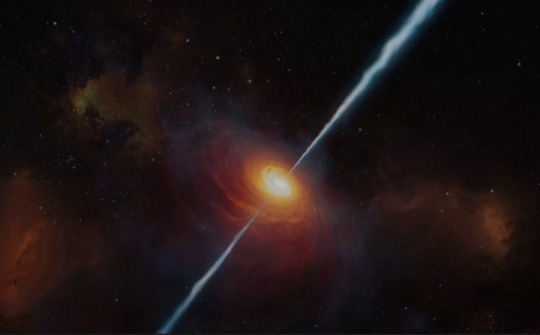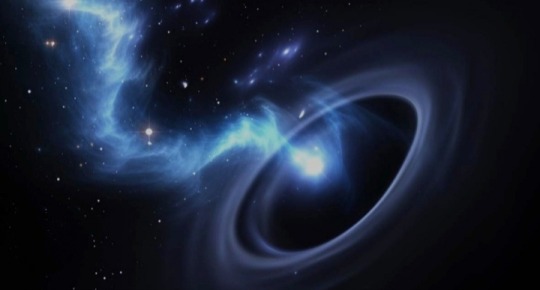#Markarian 231
Explore tagged Tumblr posts
Text

Astronomers detected molecular oxygen (breathable Oxygen)581 million light years away in galaxy Markarian 231.
This momentous “first detection of extragalactic molecular oxygen,” as it is described in a recent study in The Astrophysical Journal, has big implications for understanding the crucial role of oxygen in the evolution of planets, stars, galaxies, and life.
For the first time, astronomers have detected molecular oxygen (O2) in a galaxy outside of the Milky Way, marking a major milestone in our understanding of the universe. This discovery, led by Junzhi Wang from the Shanghai Astronomical Observatory, was made in Markarian 231, a galaxy located 581 million light years from Earth. The detection was confirmed by ground-based radio observatories, and it holds significant implications for studying planetary, stellar, and galactic evolution.

#galaxies#galaxy#astronomy#nasa#astronomers#universe#nasa photos#astrophotography#outer space#astrophysics#nasawebb#hubble space telescope#space exploration#space#science#james webb space telescope#international space station#space travel#space science#space shuttle#astronomy facts#nasa astronauts#planetary nebula#our universe#the universe#nasaastronaut#nasa jpl#nasa picture of the day#nasa science#science facts
36 notes
·
View notes
Text
TYPES OF GALAXIES, PART 7:
Quasars
This Hubble Space Telescope image reveals a bright starlike glow in the center of active galaxy Markarian 231, the nearest quasar to Earth.
©NASA, ESA, the Hubble Heritage Team (STScI/AURA)-ESA/Hubble Collaboration, and A. Evans (University of Virginia, Charlottesville/NRAO/Stony Brook University)
Quasars are the most luminous type of active galaxy. They emit light across the electromagnetic spectrum, produce powerful particle jets, and can radiate thousands of times the energy emitted by a galaxy like the Milky Way. The nearest quasar, called Markarian 231, is located some 600 million light-years away, but we see many more quasars the farther we look.
Scientists have identified over 1 million quasars, with the farthest one currently known lying about 13 billion light-years away. Since light takes time to travel, scientists can use light from these galaxies as a way to peer back in time to study black hole growth and galaxy evolution. Merging galaxies in the young universe may provide the fuel to power the enormous energy output of quasars, but when the feeding frenzy ends, the black hole cannot maintain it. It’s thought that quasar activity may be episodic and that this entire phase may last only about 10 million years.

#astronomy#astronomy facts#science#science facts#space exploration#space lovers#science is cool#science is fun#scifi geek#outer space
45 notes
·
View notes
Text

Tracklist:
Black Hole Quantum Thermodynamics • Frozen Winds of Thyraxia • Incantation of the Red Order • Forbidden Equations Deep Within the Epimethean Wasteland • The Coalescence of Nine Stars in the System Once Known as Markarian-231 • Of Tesseractual Gateways and the Grand Duplicity of Xhul • Hypercube Necrodimensions • Beyond the Wizardthrone (Cryptopharmalogical Revelations of the Riemann Zeta Function)
Spotify ♪ Bandcamp ♪ YouTube
#hyltta-polls#polls#artist: wizardthrone#language: english#decade: 2020s#Melodic Death Metal#Symphonic Black Metal#Power Metal
16 notes
·
View notes
Text

Near-earth microquasar a source of powerful radiation
Modern astronomy has clung to the belief that the relativistic outflows or jets responsible for the existence of electromagnetic radiation of particularly high energies are located in the nuclei of active galaxies distant from Earth. However, a different picture of reality is emerging from the latest data from the HAWC observatory: also jets launched in astrophysical sources from our own intra-galactic ‘backyard’ turn out to be sources of gamma photons of extremely high energy.
Electromagnetic radiation of extremely high energies is produced not only in the jets launched in active nuclei of distant galaxies, but also in jet-launching objects lying within the Milky Way, called microquasars. This latest finding by scientists from the international High-Altitude Water Cherenkov Gamma-Ray Observatory (HAWC) radically changes the previous understanding of the mechanisms responsible for the formation of ultra-high-energy cosmic radiation and in practice marks a revolution in its further study.
Since the discovery of cosmic radiation by Victor Hess in 1912, astronomers have believed that the celestial bodies responsible in our galaxy for the acceleration of these particles up to the highest energies are the remains of gigantic supernova explosions, called supernova remnants. However, a different picture is emerging from the latest data from the HAWC observatory: the sources of radiation of extremely high energies turn out to be microquasars. Astrophysicists from the Institute of Nuclear Physics of the Polish Academy of Sciences (IFJ PAN) in Cracow, co-financed by a grant from the National Science Centre, played a key role in the discovery.
The HAWC observatory was erected on the slope of the Sierra Negra volcano in Mexico with the aim of recording incoming particles and photons from space at particularly high energies. The facility consists of 300 steel water tanks equipped with photomultipliers sensitive to fleeting flashes of light, known as Cherenkov radiation. This appears in the tank when a particle travelling faster than the speed of light in water falls into it. Typically, the HAWC captures gamma photons with energies ranging from hundreds of gigaelectronvolts to hundreds of teraelectronvolts. These are energies up to a trillion times greater than the energy of visible light photons and over a dozen times greater than the energy of protons accelerated at the Large Hadronic Collider (LHC) accelerator.
The supermassive black holes within quasars, i.e. the active nuclei of some galaxies (objects with enormous masses, numbering in the hundreds of millions of solar masses) accelerate and absorb matter from the accretion disk that surrounds them. During this process, very narrow and very long streams of matter, called jets, are shot out from near the poles of the black hole, in both directions along its rotation axis. These move at velocities often close to the speed of light, resulting in shock waves – and it is there that photons of extremely high energies, reaching up to hundreds of teraelectronvolts, are produced.
Located in the nuclei of other galaxies, quasars are among objects that are very distant from us: the nearest (Markarian 231) is 600 million light years away from Earth. This is not the case for microquasars. These are compact binary systems, made up of a massive star and its matter-absorbing black hole, which emit jets with lengths of hundreds of light years. Several tens of such objects have so far been discovered in our galaxy alone.
“Photons detected from microquasars have usually much lower energies than those from the quasars. Usually, we are talking about values of the order of tens of gigaelectronvolts. Meanwhile, we have observed something quite incredible in the data recorded by the detectors of the HAWC observatory: photons coming from a microquasar lying in our galaxy and yet carrying energies tens of thousands of times higher than typical!” says Dr. Sabrina Casanova (IFJ PAN), who, together with Dr. Xiaojie Wang from Michigan Tech University and Dr. Dezhi Huang from University of Maryland were the first to observe the anomaly.
The source of photons with energies of up to 200 teraelectronvolts has been found to be the microquasar V4641 Sagittarii (V4641 Sgr). It lies in the background of the Sagittarius constellation, at a distance of about 20,000 light years from Earth. The main role here is played by a black hole with a mass of about six solar masses, pulling in matter from the stellar giant with a mass three times that of the Sun. The objects orbit around a common centre of mass, circling each other once in just under three days. Interestingly, the jet emitted by the V4641 Sgr system is directed towards the Solar System. In this configuration, an Earth-based observer has a relativistically distorted perception of the time of the matter at the beginning and end of the jet: its front begins to appear younger than it actually is. As a result, the jet seems to propagate through space at superluminal velocity, in the present case as much as nine times the speed of light.
“Significantly, the V4641 Sgr microquasar turns out not to be unique. Extremely energetic photons are meanwhile detected not only from this but also from other microquasars, detected by the LHAASO observatory. It therefore seems likely that microquasars significantly contribute to the cosmic ray radiation at the highest energies in our galaxy,” adds Dr. Casanova.
The latest discovery is of interest not only to cosmic ray scientists. It proves that at a relatively small distance from Earth, mechanisms of jet formation and production of ultra-energetic photons must be at work analogous to those in the nuclei of active, distant galaxies, scaled appropriately to the mass of the black hole. These processes in microquasars occur on a much more human-friendly timescale – over days, not hundreds of thousands or millions of years. Moreover, the photons emitted by microquasars do not have to make their way through the millions of light-years of the cosmic vacuum, where they can be scattered or absorbed during interactions with photons of the ubiquitous cosmic background radiation. All this means that astrophysicists have, for the first time, gained the ability to make comprehensive and virtually undisturbed observations of processes crucial to the evolution of galaxies.
IMAGE: Sources of high-energy cosmic rays in the vicinity of the microquasar V4641 Sag, on the left with energies above a teraelectronvolt, on the right – hundreds of teraelectronvolts. The location of the microquasar is marked with a yellow dot. Credit IFJ PAN / HAWC
5 notes
·
View notes
Text
IS QUASAR A BLACK HOLE??
Blog#289
Wednesday, April 19th, 2023
Welcome back,
A quasar is a supermassive black hole feeding on gas at the center of a distant galaxy.
Quasar is short for quasi-stellar radio source, because astronomers first discovered quasars in 1963 as objects that looked like stars but emitted radio waves.

Now, the term is a catch-all for all feeding, and therefore luminous supermassive black holes, also often called active galactic nuclei.
It’s a bit of a contradiction to call a black hole luminous; black holes themselves are, of course, black. In fact, almost every large galaxy hosts a black hole with the mass of millions to billions of Suns, and many of these black holes lurk in the dark. Our Milky Way’s behemoth weighs in at 4.3 million solar masses, but its starvation diet mutes all but faint flashes and flickers.

We know it’s there, though, from the orbits of stars around it. Other dormant black holes occasionally shred an infalling star, making their presence known by the flare of radiation that ensues.
But quasars are a different breed of black hole. They reside in galaxies with plentiful gas supplies, perhaps supplied by a recent galaxy-galaxy collision, and they gorge on the inflowing material.

The gas spirals around as it falls in, heating up in the process and emitting radiation across the electromagnetic spectrum.
Supermassive black holes in nearby galaxies typically do not have that much gas available to them, so quasars are typically found in distant galaxies. The nearest quasar is Markarian 231, which lies about 600 million light-years from Earth.


A quasar is not only the feeding black hole itself, but the light-producing structures that surround it. Visible and ultraviolet light come from the glowing disk of infalling material, while even hotter gas above the disk shines at X-ray energies. Jets shooting out along the black hole’s poles emit everything from radio waves to X-rays. Farther out from the black hole, the prolific dust and gas glow at infrared wavelengths.
The size of a quasar accretion disk, which scales with the mass of its black hole, is typically a few light-days across. That dwarfs in comparison to its host galaxy; the Milky Way for comparison is roughly 100,000 light-years across. Yet quasars often outshine their hosts.

Despite their brilliance, quasars are so small and distant that even the most powerful telescope cannot resolve all the structures within a quasar.
Astronomers have to ferret out the details using other techniques, such as analyzing spectroscopy (spreading out the light by wavelength) or light curves (spreading out the light by its arrival time).
While the details are still up for debate, we can use current knowledge to paint a general picture of a quasar. Just remember that this picture might change over time as we learn more!
Originally published on skyandtelescope.org
COMING UP!!
(Saturday, April 22nd, 2023)
"HOW LONG DO BLACK HOLES LAST??"
#astronomy#outer space#alternate universe#astrophysics#spacecraft#universe#white universe#space#parallel universe#astrophotography
85 notes
·
View notes
Text
Emerge microcuásar con potente fuente de radiación en galaxia Markarian 231
Últimos datos del observatorio HAWC surge una imagen diferente de la realidad de @ifjpan: también los chorros lanzados desde fuentes astrofísicas desde nuestro propio "patio trasero" intragaláctico en Markarian 231 resultan ser fuentes de fotones gamma de energía extremadamente alta.
Agencias/Ciudad de México.- Chorros lanzados por microcuásares desde nuestro propio “patio trasero” intragaláctico también son fuentes de fotones gamma de energía extremadamente alta. Este último hallazgo de los científicos del Observatorio Internacional de Rayos Gamma Cherenkov de Aguas a Gran Altitud (HAWC) cambia radicalmente la comprensión previa de los mecanismos responsables de la formación…
0 notes
Photo

Closest Quasar to Earth
98 notes
·
View notes
Text
I wish I had the musical technical know-how to explain why I like Wizardthrone. I just can’t explain how I went from not being impressed by it in July (I don’t like death metal in general) to playing “Frozen Winds of Thyraxia” on repeat.
That and I wish I could understand the technical side of the music to see how it was put together. As far as I can tell, a bunch of guys showed up, threw a bunch of instruments, a math and physics textbook, and a thesaurus in a pile, waved their hands over them, and then POOF!
Album.
Fucking wizards.
#Wizardthrone#Like is “The Coalescence Of Nine Stars In The System Once Known As Markarian-231” a really bouncy song or am I just being crazy?#Insidious temptations of non-Euclidean sub-temporospatial vibrations
11 notes
·
View notes
Text
Астрономи спостерігають молекулярний кисень з боку сусіднього квазара
Астрономи спостерігають молекулярний кисень з боку сусіднього квазара Спостереження, проведені за допомогою 30-метрового телескопа IRAM і інтерферометра NOEMA, виявили присутність молекулярного кисню з боку джерела Markarian 231 - найближчого до нас квазара, відомого вченим. Ці знахідки допоможуть глибше зрозуміти властивості молекулярного газу цього об'єкта. Квазари, природа яких пов'язана з надмасивними чорними дірами, що лежать в центрах далеких галактик і званих активними ядрами, мають світності, в тисячі разів перевищують світність Чумацького шляху. Відомо, що більшість квазарів викидають гігантські кількості матеріалу в батьківські галактики. Тому виявлення і спостереження таких потоків можуть допомогти отримати додаткові відомості про еволюцію галактик. Розташований на відстані приблизно 581 мільйон світлових років від Землі, джерело Markarian 231 (або скорочено Mrk 231) являє собою найближчий до нас квазар і найяскравішу надяскравих інфрачервону галактику Місцевої Всесвіту. Цей квазар характеризується високошвидкісними потоками молекулярного матеріалу, а також міліметровим випромінюванням монооксиду вуглецю. В рамках нового дослідження астрономи під керівництвом Цзюньчжі Вана (Junzhi Wang) з Шанхайської астрономічної обсерваторії, Китай, провели докладні спостереження об'єкта Mrk 231 в серпні 2015 року і грудні 2017 р за допомогою обсерваторій IRAS і NOEMA. В результаті було ідентифіковано випромінювання молекулярного кисню з боку цього джерела. Згідно ��вторам, це випромінювання O2 було виявлено на відстані приблизно 32 600 світлового років від центра джерела Mrk 231. Дослідники знайшли, що загальний потік випромінювання молекулярного кисню має швидкість близько 0,88 К * км / с, що відповідає 4,4 Ян * км / с. Було виявлено, що це значення можна співвіднести зі швидкістю червоного крила монооксиду вуглецю, перш спостережуваного в 2012 р, швидкість якого становила приблизно 2,32 Ян * км / с. Дослідники вважають, що випромінювання O2 з боку джерела Mrk 231 може бути викликано взаємодією між молекулярними потоками, породжуються активним ядром галактики, і молекулярними хмарами зовнішнього диска. Вони додають, що асиметрія розподілу випромінювання молекулярного кисню в просторі і за швидкостями може бути пов'язана з геометрією хмар молекулярного газу квазара і асиметрією молекулярного потоку, що виходить з боку центрального активного ядра галактики.
1 note
·
View note
Note
Space asks v2, the nearest and farthest pair of each section with respect to your current location (use your best judgement for any ties or ambiguity)
thanks! I’m implementing some rules of my own to facilitate this, as follows:most data comes from basic googling because if I let myself look at anything other than the little boxes there or on wikipedia, not only will I never finish the questions, I will probably die of thirst before I get to the second one. some of my numbers are probably wrong, but I’ve already spent too much time on this and I don’t want to go in and redo everything, but if anyone sees anything off please tell meties or ambiguity are generally resolved by answering both questions cuz I don’t get a lot of asks so I need to make the most of what I dofor cases in which I am basically part of one prompt, like earth, I answer that and also the next closest, for the same reasondistance to constellations will be measured as distance to the brightest star in that constellation (this may overlap with stars)distances that change significantly, like in the solar system where orbits matter, are averagedokay I think that’s it for preprocessing, it could be a lot and I feel bad cluttering up people’s dashes so here’s a read more:
Planets:Earth: Where’s your home?(average distance 0 mi, I live here) hey great question man. Pluto: What time is it right now where you are?(average distance 39.5 au) it’s quarter past 3 in the afternoon, but I’m answering this one near the start, so. Moon: What are you currently studying/hoping to study?(distance 238,900 mi) currently studying fancy light boxes with buttons, and less fancy human talk stuff. would also like to study a whole bunch of invisible stuff too, and made-up ideas a bunch of people agreed on like fifty-ish(? I don’t remember exactly, it’s probably more) years ago because it mostly makes sense. even if you can clone fake spheres with fake knives. …neither of those are full planets…aaanyway
Stars:Sun: Have you ever had alcohol?(distance 1 au, I don’t quite live there but it’s close enough) yeah, but only a little so it doesn’t really count. Deneb: Have you ever been out of your home country?(distance 2,616 ly) yeah, a few times. thinking I might want to get out permanently sometime if the nazis aren’t all taken care of soon. see, these are actually stars, thank you! learn from this, pluto
Constellations:Centaurus: Favorite holiday? (it’s…it’s alpha centauri, I mean c'mon, the closest star we’ve got; distance 4.37 ly) gosh, I’m not sure. purim’s pretty fun but I can’t eat hamentashen anymore…I do like pesach conceptually but not a fan of the whole family dinner, and I always hated doing the questions and being in the spotlight. I’m not youngest anymore though so that part isn’t really a considering I guess. Cygnus: Favorite weather?(hello, deneb again, still far as hell; in pc, 802+/-66) windy and just around the edge of warm and cool, cloudy but not fully without sun. no mud. sadly this is not very common weather around here.
Galaxies:Milky Way: Who’s your oldest friend?(yeah this is the one I’m in, right there on the edge–that arm there, see? distance 0 pc) probably a guy I’ve known since like 4th, 5th grade. but, I dunno, I guess really just me, since who else was there?Andromeda: Do you consider yourself social?(another gimme, everyone knows andromeda’s right next door, distance 2.537 million ly) sort of. I can be charming, but I’ve only got a couple social skills, and I’m absolutely awful at first impressions. I’m fine just sitting around reading or wandering around empty places all day alone, but I’ve got a decent network of people I’m friendly with. even if I am always surprised when people remember me as anything notable. Comet Galaxy: Have you ever had to leave a relationship because someone changed too much?(real far off, if you thought deneb was far–this thing’s a whole 3.2 Billion ly) I’ve never dated anyone.
Other Stuff:not exactly sure how to measure distance for this one, since it’s not specific things, I’ll just…ignore the annoying ones and get the closest instances of the rest
Asteroid: What does your dream life look like?(our solar system’s got a whole belt of them like, right there. distance like 2.2 au) shit I already answered this one, didn’t I? sorry, I meant to skip it when I was selecting because of that, but I forgot, and I don’t feel like redoing anything now, I’ve already spent too long on this. Quasar: If you could spend the rest of your life with only one person, who would it be?(man these things are cool, the closest one is at the core of the galaxy markarian 231, distance like 580 million ly, along with a pair of binary black holes–look, it’s the last one, I can do extra research if I want) I really don’t know. I’m pretty sure that if I had to be like, constantly around one person for that long, either I would murder them, or they’d murder me. honestly the only exception would probably be a duplicate of me or something–that sounds really self-centered, but really, I just have serious trust issues (that I'm working on).
thanks for the questions, and thanks to anyone who read the whole thing. as always I’m still taking them, and there’s no ask-by time (especially for space ones).
1 note
·
View note
Text
اكتشاف غاز الأكسجين فى مجرة خارج درب التبانة لأول مرة
اكتشاف غاز الأكسجين فى مجرة خارج درب التبانة لأول مرة
[ad_1]

اكتشف علماء الفلك الأكسجين الجزيئي في مجرة خارج درب التبانة لأول مرة على الإطلاق، حيث تم رصده بواسطة فريق من علماء الفلك في مرصد شنغهاي الفلكي، وحدد الفريق وجود الأكسجين الجزيئي من خلال تحليل موجات الضوء التي وصلت إلى الأرض من Markarian 231، وهي مجرة تبعد حوالي 581 مليون سنة ضوئية.
ووفقا لما ذكرته صحيفة “ديلى ميل” البريطانية فيتم امتصاص هذه الموجات الضوئية أو إعادة توجيهها…
View On WordPress
0 notes
Text
Researchers First Explored Oxygen Molecule Outside The Solar System

Researchers initially found an oxygen particle outside the Solar System. How the oxygen atom found in the Markarian 231 cosmic system started is being investigated. Space experts went over an atom of oxygen in a cosmic system a huge number of light a long time from Earth. This disclosure likewise uncovered the principal oxygen particle distinguished outside the Solar framework. Research will help comprehend the job of oxygen particles in different systems. The investigation, distributed in The Astrophysical Journal, expressed that the oxygen particle was found in the Markarian 231 universe, 561 million light years from Earth. Markarian 231 draws its vitality from quasar. Kuasar is an exceptionally cleaned galactic center with an enormous dynamic dark gap in the focal point of Markarian. The group, who analyzed with the IRAM-30 radio telescope in Spain, saw the radio waves that they recognized sub-atomic oxygen following four days of perceptions. The scientists have not yet discovered what oxygen is delivering. In any case, they recommend that it might be brought about by the collaboration between atomic arrangements dependent on the dynamic galactic core and sub-atomic mists in the external circle of the cosmic system. Stargazers believe that two enormous mass dynamic dark openings in the focal point of the Markarian 231 might be pivoting each other at extraordinary speed. The dynamic galactic core may make atoms move away from the middle, making the oxygen in the sub-atomic mists discrete. Oxygen is the third most inexhaustible component known to mankind after hydrogen and helium. A few researchers accept that oxygen joins with hydrogen in space and is in ice structure. So it is very hard to distinguish oxygen particles in inaccessible cosmic systems. Read the full article
0 notes
Link



Pela primeira vez, os astrônomos encontraram oxigênio molecular, o mesmo gás que nós, seres humanos precisamos para respirar, numa outra galáxia que não é a Via Láctea. O oxigênio é o terceiro elemento mais comum no cosmos, só fica atrás do hidrogênio e do hélio. Então os astrônomos pensaram que o oxigênio molecular, o O2 poderia ser comum no espaço entre as estrelas. Mas apesar de repetidas buscas, eles nunca tinham encontrado o oxigênio molecular, em outras galáxias, mas isso era até agora. Astrônomos do Observatório Astronômico de Shanghai na China, registraram a molécula na galáxia Markarian 231 localizada a aproximadamente 560 milhões de anos-luz de distância da Terra, na constelação de Ursa Maior. Essa galáxia tem no seu núcleo um buraco negro supermassivo, que está se alimentando violentamente e por isso ela recebe a denominação de quasar, na verdade esse é o quasar mais próximo da Terra. Usando radio-telescópios na Espanha e na França, os astrônomos observaram a radiação no comprimento de onda de 2.52 milímetros, uma assinatura da presença de O2. Além de ter detectado o oxigênio molecular numa galáxia, essa foi a maior quantidade dessa molécula já detectada fora do Sistema Solar. Anteriormente, os astrônomos haviam detectado a molécula em duas nuvens de formação de estrelas, dentro da Via Láctea, a Nebulosa de Orion e na nuvem Rho Ophiuchi. Os astrônomos acreditam que o O2 interestelar tem origem nos átomos de oxigênio e nas moléculas de água congeladas nos grãos de poeira, que acabam aprisionando o oxigênio. Nesses berçários estelares, as ondas de choques das estrelas recém-nascidas podem arrancar a água da poeira, liberando os átomos de oxigênio que podem então se combinar formando a molécula de O2. Mas mesmo, na Nebulosa de Orion, o oxigênio molecular é raro, com moléculas de hidrogênio superando o número de moléculas de oxigênio numa razão de 1 milhão para 1. O hidrogênio também domina a Markarian 231, mas o oxigênio molecular se espalha na periferia do disco galáctico numa quantidade 100 vezes maior do que na Nebulosa de Orion. Esse é um valor muito alto, não existe ainda uma explicação para essa abundância de oxigênio molecular. E para confirmar isso, os astrônomos irão observar um segundo comprimento de onda dessa molécula. Não vai ser algo fácil, pois outras moléculas também emitem radiação nesses comprimentos de onda. Para ter certeza da detecção do O2, os cientistas irão investigar muitas moléculas em determinados comprimentos de onda, procurar essas moléculas no espaço, e quando encontrar algo diferente, terão encontrado o O2. Vai ser por eliminação. Uma das possíveis explicações para o O2 na Markarian 231, é que ela passa por um processo muito mais vigoroso do que aquele que acontece na Nebulosa de Orion. A galáxia é uma bela fábrica de estrelas, produzindo 100 vezes mais estrelas que a nossa Via Láctea, e gerando 700 massas solares de gás por ano. O gás em alta velocidade no centro da galáxia pode colidir com o gás no disco, arrancar o gelo de água da poeira e assim as moléculas de O2 se formam. Esse oxigênio poderia manter a galáxia hiperativa, a radiação emitida pela molécula ajuda a esfriar o gás de modo que alguma parte pode colapsar, e criar mais novas estrelas na galáxia. Fonte: https://www.sciencenews.org/article/molecular-oxygen-spotted-beyond-milky-way-first-time
0 notes
Text
L'ossigeno molecolare è stato individuato per la prima volta al di là della Via Lattea
L’ossigeno molecolare è stato individuato per la prima volta al di là della Via Lattea


Gli astronomi hanno finalmente trovato l’ossigeno molecolare oltre la Via Lattea, ma hanno dovuto guardare una galassia molto, molto lontana: il quasar Markarian 231, mostrato qui in un’immagine del telescopio spaziale Hubble.
L’elusiva molecola è apparsa in un quasar a più di mezzo miliardo di anni luce dalla Terra.
Per la prima volta, gli astronomi hanno trovato l’ossigeno…
View On WordPress
0 notes
Text
#новости | Открытие. Молекулярный кислород впервые нашли за пределами нашей галактики - новости Украины, Мир
#новости | Открытие. Молекулярный кислород впервые нашли за пределами нашей галактики – новости Украины, Мир
Двойная черная дыра в центре Mrk 231 (иллюстрация – NASA/ESA/G. Bacon/STScI)
В одном из наиболее ярких и активных мест в наблюдаемой Вселенной зафиксирован молекулярный кислород. Это лишь третий случай обнаружения такого элемента за пределами Солнечной системы, и первый – вне Галактики, пишет со ссылкой на The Astrophysical Journal сайт ScienceAlert.
Находка – в галактике Markarian 231 в…
View On WordPress
#впервые#Галактики#за#кислород#Мир#Молекулярный#нашей#нашли#Новости#Новости Украины#открытие#пределами#Украины
0 notes
Text
Astronomers Have Detected Molecular Oxygen in Another Galaxy For The First Time
Astronomers Have Detected Molecular Oxygen in Another Galaxy For The First Time
In a wild galaxy over half a billion light-years away, astronomers have detected molecular oxygen. It’s only the third such detection ever outside the Solar System – and the first outside the Milky Way.
Oxygen is the third most abundant element in the Universe, behind hydrogen (naturally) and helium. So its chemistry and abundance in interstellar clouds are important for understanding the…
View On WordPress
#&quot#231#abundance#active#astronomers#but#detected#galactic#Galaxy#markarian#molecular#molecules#orion#oxygen#rate#time#Water
0 notes